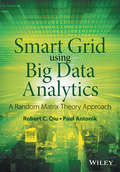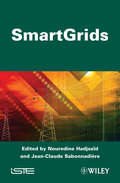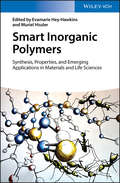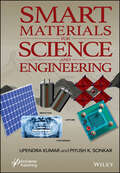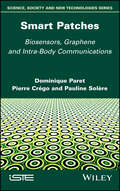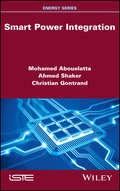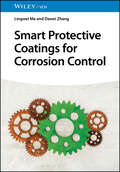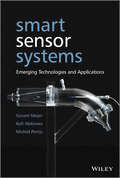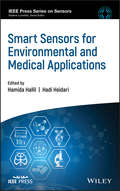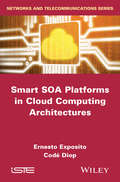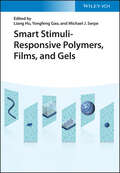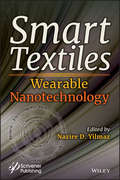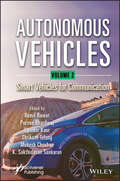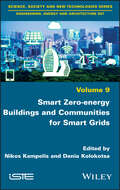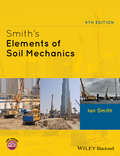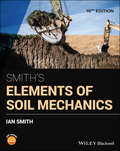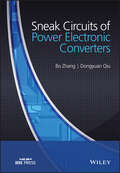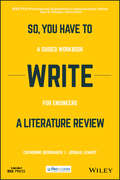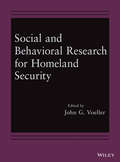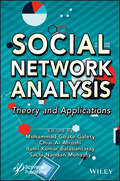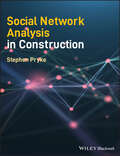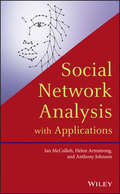- Table View
- List View
Smart Grid using Big Data Analytics: A Random Matrix Theory Approach
by Paul Antonik Robert C. QiuThis book is aimed at students in communications and signal processing who want to extend their skills in the energy area. It describes power systems and why these backgrounds are so useful to smart grid, wireless communications being very different to traditional wireline communications.
Smart Grids
by Nouredine Hadjsaïd Jean-Claude SabonnadièreOn a worldwide basis, the development of SmartGrids is a consistent answer to the problem of an efficient and sustainable delivery of electric energy through distribution grids. SmartGrids are a combination of information and communication technologies and new energy technologies. There are many different definitions of the concept of SmartGrids and thus it appears indispensable to gather the knowledge available from both industry and research laboratories in one book. Distributed generation is rightly receiving an increased amount of attention and will become an integral part of urban energy systems, providing consumers and energy providers with safe, affordable, clean, reliable, flexible and readily-accessible energy services.The aim of this book is to describe future electricity networks that will enable all energy services to become sustainable. The traditional design of network control systems with a centralized structure is not in-line with the paradigm of the unbundled electricity system and decentralized control; this is highlighted by looking at how future active networks will efficiently link small- and medium-scale power sources with consumer demands, allowing decisions to be made on how best to operate in real time. It also looks at the level of control required: power flow assessment, voltage control and protection require cost-competitive technologies and new communication systems with more sensors and actuators than presently used, certainly in relation to the distribution systems. To manage active networks, a vision of grid computing is created that assures universal access to computing resources. An intelligent grid infrastructure gives more flexibility concerning demand and supply, providing new instruments for optimal and cost-effective grid operation at the same time.
Smart Inorganic Polymers: Synthesis, Properties, and Emerging Applications in Materials and Life Sciences
by Evamarie Hey-Hawkins Muriel HisslerProvides complete and undiluted knowledge on making inorganic polymers functional This comprehensive book reflects the state of the art in the field of inorganic polymers, based on research conducted by a number of internationally leading research groups working in this area. It covers the synthesis aspects of synthetic inorganic polymers and looks at multiple inorganic monomers as building blocks, which exhibit unprecedented electronic, redox, photo-emissive, magnetic, self-healing and catalytic properties. It also looks at the applications of inorganic polymers in areas such as optoelectronics, energy storage, industrial chemistry, and biology. Beginning with an overview of the use of smart inorganic polymers in daily life, Smart Inorganic Polymers: Synthesis, Properties and Emerging Applications in Materials and Life Sciences goes on to study the synthesis, properties, and applications of polymers incorporating different heteroelements such as boron, phosphorus, silicon, germanium, and tin. The book also examines inorganic polymers in flame-retardants, as functional materials, and in biology. -An excellent addition to the polymer scientists' and synthetic chemists' toolbox -Summarizes the state of the art on how to make and use functional inorganic polymers?from synthesis to applications -Edited by the coordinator of a highly funded European community research program (COST action) that focuses specifically on the exploration of inorganic polymers -Features contributions from top experts in the field Aimed at academics and industrial researchers in this field, Smart Inorganic Polymers: Synthesis, Properties and Emerging Applications in Materials and Life Sciences will also benefit scientists who want to get a better overview on the state-of-the-art of this rapidly advancing area.
Smart Materials for Science and Engineering
by Upendra Kumar Piyush Kumar SonkarSMART MATERIALS FOR SCIENCE AND ENGINEERING Smart materials, also known as advanced or creative materials, are described as advanced materials that react intuitively to environmental changes or as materials that can return to their original shape in response to certain stimuli. Smart materials are classified as either active or passive based on their characteristics. There are two types of active materials. The first kind cannot change its characteristics when subjected to outside stimuli, for example photochromatic spectacles that only alter their color when exposed to sunlight. The other, which includes piezoelectric materials, can change one sort of energy (thermal, electrical, chemical, mechanical, or optical) into another. When subjected to external pressure, it can generate an electric charge. As an example, optical fibers can transmit electromagnetic waves. In contrast, passive smart materials can transmit a specific sort of energy. They have some amazing qualities that set them apart from other materials, such as transiency, meaning they can react to different kinds of external stimuli immediately, self-actuation or the capacity to change their appearance and shape, selectivity where the response is divided and expected, directness when the response is limited to the activating event, shape-changing where the material can change its shape to external stimuli, their ability to determine their own health, also known as self-diagnosis, and their ability to self-heal. The ability to synthesize novel materials has substantially progressed thanks to science and technology over the past 20 years. They fall mostly into the following four categories: polymers, ceramics, metals, and smart materials. Among these, smart materials are gaining popularity since they have more uses than conventional materials. Smart materials are unusual substances that have the ability to alter their properties, such as those that can immediately change their phase when placed near a magnet or their shape simply by applying heat. Humanity will be significantly impacted by this new era of smart materials. For instance, some of them can adapt their properties to the environment, some have sensory capabilities, some can repair themselves automatically, and some can degrade themselves. These extraordinary properties of smart materials will have an effect on all facets of civilization. There are many different types of intelligent materials, including magnetorheological materials, electro-rheostat materials, shape memory alloys, piezoelectric materials, and more. This book describes many forms of smart materials and their possible uses in various fields. A literature survey discusses the different types of smart materials, such as based ceramics, polymers, and organic compounds and their needs, advantages, disadvantages, and applications will be comprehensively discussed. A discussion of well-established smart materials including piezoelectric, magnetostrictive, shape memory alloy, electro-rheological fluid, and magnetorheological fluid materials will be discussed with their present prospects.
Smart Patches: Biosensors, Graphene, and Intra-Body Communications
by Dominique Paret Pierre Crego Pauline SolereThis book defines and elucidates the topic of smart "second skin" clothing, which must be flexible, washable, ironable, long-lasting and battery-free. We explore the possibilities for its use in fields such as health, well-being, sports and leisure. Smart Patches presents techniques that can be used within the limits established by regulations (EMC, normative, GDPR, ANSES, etc.) to help make smart clothing a marketable product at an affordable price. This book studies the creation and performance of various sensors and biosensors based on graphene materials and describes the functioning of Intra-Body Communications (IBC), as well as all the internal and external parameters involved in this type of technology. The performances and limits of these IBC and technologies are presented, together with concrete application examples.
Smart Power Integration
by Ahmed Shaker Christian Gontrand Mohamed AbouelattaSmart power integration is at the crossroads of different fields of electronics such as high and low power, engine control and electrothermal studies of devices and circuits. These circuits are complex and are heavily influenced by substrate coupling, especially where 3D integration is concerned. This book provides an overview of smart power integration, including high voltage devices, dedicated and compatible processes, as well as isolation techniques.Two types of integration are highlighted: modular or hybrid integration, together with compatible devices such as the insulated gate bipolar transistor (IGBT); and monolithic integration, specifically through the paradigm of functional integration. Smart Power Integration outlines the main MOS devices for high voltage integrated circuits, and explores into the fields of codesign, coupling hardware and software design, including applications to motor control. Studies focusing on heat pipes for electronics cooling are also outlined.
Smart Protective Coatings for Corrosion Control
by Lingwei Ma Dawei ZhangSmart Protective Coatings for Corrosion Control Overview of the latest research in advanced coatings for anticorrosion and the development of optimized surfaces with high anticorrosion ability Smart Protective Coatings for Corrosion Control introduces the newest research developments in self-healing coatings, self-reporting coatings, and superhydrophobic coatings, reviewing corrosion processes and strategies, smart coatings for corrosion protection, techniques for synthesizing and applying smart coatings, different kinds of self-healing and self-reporting coatings activated by different environmental stimuli, and current and future trends of protective coatings for automotive, aerospace, marine, nuclear, oil/gas, and military applications. This book also discusses new ideas in the field, such as the combination of self-healing and self-reporting properties, new techniques to study localized microscale electrochemical corrosion behavior, as well as atmospheric corrosion monitor technique to study the real-time protection behavior of coatings in different environments. The processes of coating degradation and metal corrosion are discussed in detail so that non-experts can gain a basic understanding of the corrosion protection techniques. Written by two highly qualified academics with significant research experience in the field, Smart Protective Coatings for Corrosion Control includes information on: Coating preparation, filler preparation, surface characterization, macroscopic and microscopic electrochemical properties, and self-healing performance of self-healing coating systems under different environmental stimuliPhotothermal conversion species such as graphene oxide, titanium nitride, and Fe3O4Different types of corrosion indicators, such as phenolphthalein, sulfosalicylic acid-modified carbon dots, and phenanthrolineHigh-mobility polymer networks that endow a shape memory effect and allow coatings to recover their original shape and barrier propertiesSolutions to three corrosion conditions—room temperature immersion, alternating wet-dry, and outdoor atmospheric exposure conditions Presenting the latest research in the field, Smart Protective Coatings for Corrosion Control is a practical and highly valuable reference on the subject for scientists, researchers, and students in diverse programs of study.
Smart Sensor Systems
by Michiel Pertijs Gerard Meijer Kofi MakinwaUses a multidisciplinary approach to review recent developments in the field of smart sensor systems, providing complete coverage of all important system and design aspects, their building blocks and methods of signal processing.The book systematically deals with topics over the whole range of sensor technology: from the theory and constraints of basic elements, the applied techniques and electronic, up to the level of application-orientated issues.It firstly looks at designing smart sensors and smart sensor systems, with measurement techniques at system level, such as collaboration and trimming, and impedance-measurement techniques. Sensing elements and sensor systems for the measurement of mechanical quantities, and microarrays for DNA detection are discussed in the opening chapters. Circuit design for sensor systems, such as the design of low-noise amplifiers, is covered in Chapter 6, and measurement techniques at device level, such as dynamic offset cancellation, are covered in Chapter 7. Optical imagers are examined in the next chapter. Lastly, the book takes a look at implantable smart sensors for bio-medical applications, then automotive sensors.Complements Smart Sensor Systems (2008) in both contents and scope. Where the first book offers an introduction and theory, this book goes further into the practical applicationsOffers a detailed coverage of sensor principles and characterization, measurement techniques and signal- and data processing techniques as applied in smart sensor systemsA wide range of application areas are included, such as automotive and biomedical, written by an internationally-recognized group of experts, many from industryA supplementary website hosts case studies and provides solutions to the problems in the bookEssential reading for Engineers and scientists involved in the design and application of sensor systems; research and development departments and laboratories of industrial companies, and other research institutes; product developers, industrial engineers, industrial set makers looking for innovative products.
Smart Sensors for Environmental and Medical Applications (IEEE Press Series on Sensors)
by Hamida Hallil Hadi HeidariProvides an introduction to the topic of smart chemical sensors, along with an overview of the state of the art based on potential applications This book presents a comprehensive overview of chemical sensors, ranging from the choice of material to sensor validation, modeling, simulation, and manufacturing. It discusses the process of data collection by intelligent techniques such as deep learning, multivariate analysis, and others. It also incorporates different types of smart chemical sensors and discusses each under a common set of sub-sections so that readers can fully understand the advantages and disadvantages of the relevant transducers—depending on the design, transduction mode, and final applications. Smart Sensors for Environmental and Medical Applications covers all major aspects of the field of smart chemical sensors, including working principle and related theory, sensor materials, classification of respective transducer type, relevant fabrication processes, methods for data analysis, and suitable applications. Chapters address field effect transistors technologies for biological and chemical sensors, mammalian cell–based electrochemical sensors for label-free monitoring of analytes, electronic tongues, chemical sensors based on metal oxides, metal oxide (MOX) gas sensor electronic interfaces, and more. Addressing the limitations and challenges in obtaining state-of-the-art smart biochemical sensors, this book: Balances the fundamentals of sensor design, fabrication, characterization, and analysis with advanced methods Categorizes sensors into sub-types and describes their working, focusing on prominent applications Describes instrumentation and IoT networking methods of chemical transducers that can be used for inexpensive, accurate detection in commercialized smart chemical sensors Covers monitoring of food spoilage using polydiacetylene- and liposome-based sensors; smart and intelligent E-nose for sensitive and selective chemical sensing applications; odor sensing system; and microwave chemical sensors Smart Sensors for Environmental and Medical Applications is an important book for senior-level undergraduate and graduate students learning about this high-performance technology and its many applications. It will also inform practitioners and researchers involved in the creation and use of smart sensors.
Smart SOA Platforms in Cloud Computing Architectures
by Ernesto Exposito Codé DiopThis book is intended to introduce the principles of the Event-Driven and Service-Oriented Architecture (SOA 2.0) and its role in the new interconnected world based on the cloud computing architecture paradigm. In this new context, the concept of “service” is widely applied to the hardware and software resources available in the new generation of the Internet. The authors focus on how current and future SOA technologies provide the basis for the smart management of the service model provided by the Platform as a Service (PaaS) layer.
Smart Stimuli-Responsive Polymers, Films, and Gels: Polymers, Films, And Gels
by Liang Hu Yongfeng Gao Michael J. SerpeSmart Stimuli-Responsive Poymers, Films, and Gels Discover the most important developments in synthesis, simulation, and applications of a fascinating compound class There exist a range of natural materials that respond to environmental changes by altering their physical or chemical properties, known as stimuli-responsive polymers, these substances are responsive to light, temperature, pressure, and more. The study of these so-called “smart” polymers is essential to a range of application fields, many of which have generated cutting-edge research in recent decades. A comprehensive introduction to the subject is therefore well-timed Smart Stimuli-Responsive Polymers, Films, and Gels provides an introduction to these polymers and their applications. It includes producing these polymers through synthetic approaches, simulating their responses to different stimuli, and applying these materials in different industries and research capacities. Written to serve the requirements of advanced students and senior researchers alike, this timely work will drive years of research in this vital field. In Smart Stimuli-Responsive Polymers, Films, and Gels readers will also find: Treatment of mechanoresponsive, photoresponsive, and ionizing-radiation responsive polymers Applications in emerging fields such as sensors, biomedicine, catalysis, and more Interdisciplinary research into the properties and responses of these vital compounds Smart Stimuli-Responsive Polymers, Films, and Gels promises to become a seminal work for chemists, materials scientists, and industrial researchers seeking to incorporate these materials into a variety of industrial and research areas.
Smart Textiles: Wearable Nanotechnology
by Nazire Daniz YilmazSmart Textiles: Wearable Nanotechnology provides a comprehensive presentation of recent advancements in the area of smart nanotextiles giving specific importance to materials and production processes. Different materials, production routes, performance characteristics, application areas and functionalization mechanisms are covered. The book provides a guideline to students, researchers, academicians and technologists who seek novel solutions in the related area by including groundbreaking advancements in different aspects of the diverse smart nanotextiles fields. This ground-breaking book is expected to spark an inspiration to allow future progress in smart nanotextiles research. The diversity of the topics, as well as the expert subject-matter contributors from all over the world representing various disciplines, ensure comprehensiveness and a broad understanding of smart nanotextiles.
Smart Vehicles for Communication: Autonomous Vehicles Volume 2
by Romil Rawat Purvee Bhardwaj Upinder Kaur Shrikant Telang Mukesh Chouhan K. Sakthidasan SankaranAUTONOMOUS VEHICLES The companion to Autonomous Vehicles Volume 1: Using Machine Intelligence, this second volume in the two-volume set covers intelligent techniques utilized for designing, controlling, and managing vehicular systems based on advanced algorithms of computing like machine learning, artificial intelligence, data analytics, and Internet of Things (IoT) with prediction approaches to avoid accidental damages, security threats, and theft. Besides communicating with other vehicles, self-driving cars connected to a 5G network will also be able to communicate with different infrastructure elements that make up our roads and other transportation and communication systems. Similarly, an unmanned aerial vehicle (UAV), an aircraft without any human pilot, crew, or passengers on board, can operate under remote control by a human operator, as a remotely-piloted aircraft (RPA), or with various degrees of autonomy. These include autopilot assistance and fully autonomous aircraft that have no provision for human intervention. Transportation is a necessary, but often painful process. With fully autonomous driving, passengers will be freed to accomplish their own goals, turning the dead hours of driving into fruitful hours of learning, working, engaging, and relaxing. Similarly, UAVs can perform functions that human-operated aircraft cannot, whether because of the environment or high-risk situations. The purpose of the book is to present the needs, designs, and applications of autonomous vehicles. The topics covered range from mechanical engineering to computer science engineering, both areas playing vital roles in programming, managing, generating alerts, and GPS position, artificial intelligence-based prediction of path and events, as well as other high-tech tools, are covered in this book, as well. Whether for the student, veteran engineer, or another industry professional, this book, and its companion volume, are must-haves for any library.
Smart Zero-energy Buildings and Communities for Smart Grids
by Nikos Kampelis Denia KolokotsaSmart zero-energy buildings and communities have a major role to play in the evolution of the electric grid towards alignment with carbon neutrality policies. The goal to reduce greenhouse gas emissions in the built environment can be pursued through a holistic approach, including the drastic reduction of buildings’ energy consumption.The state-of-the-art in this field relates, on the one hand, to design methodologies and innovative technologies which aim to minimize the energy demand at the building level. On the other hand, the development of information and communication technologies, along with the integration of renewable energy and storage, provide the basis for zero and positive energy buildings and communities that can produce, store, manage and exchange energy at a local level.This book provides a structured and detailed insight of the state-of-the-art in this context based on the analysis of real case studies and applications.
Smith, Currie & Hancock's Common Sense Construction Law: A Practical Guide for the Construction Professional
by John M. Mastin Eric L. Nelson Ronald G. Robey Smith, Currie & Hancock LLPThe #1 construction law guide for construction professionals Updated and expanded to reflect the most recent changes in construction law, this practical guide teaches readersthe difficult theories, principles, and established rules that regulate the construction business. It addresses the practical steps required to avoid and mitigate risks—whether the project is performed domestically or internationally, or whether it uses a traditional design-bid-build delivery system or one of the many alternative project delivery systems. Smith, Currie & Hancock's Common Sense Construction Law: A Practical Guide for the Construction Professional provides a comprehensive introduction to the important legal topics and questions affecting the construction industry today. This latest edition features: all-new coverage of Electronically Stored Information (ESI) and Integrated Project Delivery (IPD); extended information on the civil False Claims Act; and fully updated references to current AIA, ConsensusDocs, DBIA, and EJDC contract documents. Chapters coverthe legal context of construction; interpreting a contract; public-private partnerships (P3); design-build and EPC; and international construction contracts. Other topics include: management techniques to limit risks and avoid disputes; proving costs and damages, including for changes and claims for delay and disruption; construction insurance, including general liability, builders risk, professional liability, OCIP, CCIP, and OPPI; bankruptcy; federal government construction contracting; and more. Fully updated with comprehensive coverage of the significant legal topics and questions that affect the construction industry Discusses new project delivery methods including Public-Private Partnerships (P3) and Integrated Project Delivery (IPD) Presents new coverage of digital tools and processes including Electronically Stored Information (ESI) Provides extended and updated coverage of the civil False Claims Act as it relates to government construction contracting Filled with checklists, sample forms, and summary “Points to Remember” for each chapter, Smith, Currie & Hancock's Common Sense Construction Law: A Practical Guide for the Construction Professional, Sixth Edition is the perfect resource for construction firm managers, contractors, subcontractors, architects and engineers. It will also greatly benefit students in construction management, civil engineering, and architecture.
Smith's Elements of Soil Mechanics
by Ian SmithThe 9th edition maintains the content on all soil mechanics subject areas - groundwater flow, soil physical properties, stresses, shear strength, consolidation and settlement, slope stability, retaining walls, shallow and deep foundations, highways, site investigation - but has been expanded to include a detailed explanation of how to use Eurocode 7 for geotechnical design. The key change in this new edition is the expansion of the content covering Geotechnical Design to Eurocode 7. Redundant material relating to the now defunct British Standards - no longer referred to in degree teaching - has been removed. Building on the success of the earlier editions, this 9th edition of Smith’s Elements of Soil Mechanics brings additional material on geotechnical design to Eurocode 7 in an understandable format. Many worked examples are included to illustrate the processes for performing design to this European standard. Significant updates throughout the book have been made to reflect other developments in procedures and practices in the construction and site investigation industries. More worked examples and many new figures have been provided throughout. The illustrations have been improved and the new design and layout of the pages give a lift. unique content to illustrate the use of Eurocode 7 with essential guidance on how to use the now fully published code clear content and well-organised structure takes complicated theories and processes and presents them in easy-to-understand formats book's website offers examples and downloads to further understanding of the use of Eurocode 7 www.wiley.com/go/smith/soil
Smith's Elements of Soil Mechanics
by Ian SmithSmith’s Elements of Soil Mechanics The revised 10th edition of the core textbook on soil mechanics The revised and updated edition of Smith’s Elements of Soil Mechanics continues to offer a core undergraduate textbook on soil mechanics. The author, a noted expert in geotechnical engineering, reviews all aspects of soil mechanics and provides a detailed explanation of how to use both the current and the next versions of Eurocode 7 for geotechnical design. Comprehensive in scope, the book includes accessible explanations, helpful illustrations, and worked examples and covers a wide range of topics including slope stability, retaining walls and shallow and deep foundations. The text is updated throughout to include additional material and more worked examples that clearly illustrate the processes for performing testing and design to the new European standards. In addition, the book’s accessible format provides the information needed to understand how to use the first and second generations of Eurocode 7 for geotechnical design. The second generation of this key design code has seen a major revision and the author explains the new methodology well, and has provided many worked examples to illustrate the design procedures. The new edition also contains a new chapter on constitutive modeling in geomechanics and updated information on the strength of soils, highway design and laboratory and field testing. This important text: Includes updated content throughout with a new chapter on constitutive modeling Provides explanation on geotechnical design to the new version of Eurocode 7 Presents enhanced information on laboratory and field testing and the new approach to pavement foundation design Provides learning outcomes, real-life examples, and self-learning exercises within each chapter Offers a companion website with downloadable video tutorials, animations, spreadsheets and additional teaching materials Written for students of civil engineering and geotechnical engineering, Smith’s Elements of Soil Mechanics, 10th Edition covers the fundamental changes in the ethos of geotechnical design advocated in the Eurocode 7.
Sneak Circuits of Power Electronic Converters (Wiley - IEEE)
by Bo Zhang Dongyuan QiuThe first treatment of advanced knowledge of electrical sneak circuits and its analysis method in power electronics The work on sneak circuit and its analysis methods for power converters contributes to the reliability of power electronic systems worldwide. Most books in the subject concentrate on electronic systems, but this book is perhaps the first to examine power electronic systems. It describes the sneak circuit phenomena in power converters, introduces some SCA methods for power electronic systems and proposes how to eliminate and make use of sneak circuits. The book is divided into three separate sections. Firstly, the sneak circuit paths and sneak circuit operating conditions are discussed in different kinds of power converters, including resonant switched capacitor converters, basic DC-DC converters, soft-switching converters and Z-source converters; Secondly, the sneak circuit analysis guidelines for power converters based on generalized matrix, adjacency matrix and Boolean matrix are presented respectively; Thirdly, the sneak circuit elimination techniques are introduced and verified in several power converters, with applications of sneak circuits described in conclusion. Written by a lead author with extensive academic and industrial experience, the book provides a complete introduction and reference to students and professionals alike. Contents include: Fundamental Concepts, SCA of Resonant Switched Capacitor Converters, SC of DC-DC Converters, SC Analysis Method (including Boolian Matrix), and Applications of SC in Power Converters. Highlights the advanced research works in the sneak circuit analysis, by a leading author in the field Original in its treatment of power electronics converters; most other books concentrating on electronics systems, and aimed at both introductory and advanced levels Offers guidelines for industry professionals involved in the design of power electronic systems, enabling early detection of potential problems Essential reading for Graduate students in Electrical Engineering: Engineers and Researchers in Power Electronics
So, You Have to Write a Literature Review: A Guided Workbook for Engineers (IEEE PCS Professional Engineering Communication Series)
by Catherine Berdanier Joshua LenartIs a literature review looming in your future? Are you procrastinating on writing a literature review at this very moment? If so, this is the book for you. Writing often causes trepidation and procrastination for engineering students—issues that compound while writing a literature review, a type of academic writing most engineers are never formally taught. Consider this workbook as a "couch-to-5k" program for engineering writers rather than runners: if you complete the activities in this book from beginning to end, you will have a literature review draft ready for revision and content editing by your research advisor. So, You Have to Write a Literature Review presents a dynamic and practical method in which engineering students—typically late-career undergraduates or graduate students—can learn to write literature reviews, and translate genre-based writing instruction into easy-to-follow, bite-sized activities and content. Written in a refreshingly conversational style while acknowledging that writing is quite difficult, Catherine Berdanier and Joshua Lenart leverage their unique disciplinary backgrounds with decades of experience teaching academic engineering writing in this user-friendly workbook.
Social and Behavioral Research for Homeland Security
by John G. VoellerSocial and Behavioral Research for Homeland Security features articles from the Wiley Handbook of Science and Technology for Homeland Security covering social and psychological aspects of terrorism and counterterrorism efforts from different perspectives. First, it examines the roots of terrorism; second, it explores the consequences of terrorism; then communication, training, and learning development of responders and the public in situations of terror attacks, are discussed.
Social-Behavioral Modeling for Complex Systems (Stevens Institute Series on Complex Systems and Enterprises)
by Paul K. Davis Angela O'Mahony Jonathan PfautzThis volume describes frontiers in social-behavioral modeling for contexts as diverse as national security, health, and on-line social gaming. Recent scientific and technological advances have created exciting opportunities for such improvements. However, the book also identifies crucial scientific, ethical, and cultural challenges to be met if social-behavioral modeling is to achieve its potential. Doing so will require new methods, data sources, and technology. The volume discusses these, including those needed to achieve and maintain high standards of ethics and privacy. The result should be a new generation of modeling that will advance science and, separately, aid decision-making on major social and security-related subjects despite the myriad uncertainties and complexities of social phenomena. Intended to be relatively comprehensive in scope, the volume balances theory-driven, data-driven, and hybrid approaches. The latter may be rapidly iterative, as when artificial-intelligence methods are coupled with theory-driven insights to build models that are sound, comprehensible and usable in new situations. With the intent of being a milestone document that sketches a research agenda for the next decade, the volume draws on the wisdom, ideas and suggestions of many noted researchers who draw in turn from anthropology, communications, complexity science, computer science, defense planning, economics, engineering, health systems, medicine, neuroscience, physics, political science, psychology, public policy and sociology. In brief, the volume discusses: Cutting-edge challenges and opportunities in modeling for social and behavioral science Special requirements for achieving high standards of privacy and ethics New approaches for developing theory while exploiting both empirical and computational data Issues of reproducibility, communication, explanation, and validation Special requirements for models intended to inform decision making about complex social systems
Social Network Analysis: Theory and Applications
by Mohammad Gouse Galety Chiai Al Atroshi Bunil Kumar Balabantaray Sachi Nandan MohantySOCIAL NETWORK ANALYSIS As social media dominates our lives in increasing intensity, the need for developers to understand the theory and applications is ongoing as well. This book serves that purpose. Social network analysis is the solicitation of network science on social networks, and social occurrences are denoted and premeditated by data on coinciding pairs as the entities of opinion. The book features: Social network analysis from a computational perspective using python to show the significance of fundamental facets of network theory and the various metrics used to measure the social network. An understanding of network analysis and motivations to model phenomena as networks. Real-world networks established with human-related data frequently display social properties, i.e., patterns in the graph from which human behavioral patterns can be analyzed and extracted. Exemplifies information cascades that spread through an underlying social network to achieve widespread adoption. Network analysis that offers an appreciation method to health systems and services to illustrate, diagnose, and analyze networks in health systems. The social web has developed a significant social and interactive data source that pays exceptional attention to social science and humanities research. The benefits of artificial intelligence enable social media platforms to meet an increasing number of users and yield the biggest marketplace, thus helping social networking analysis distribute better customer understanding and aiding marketers to target the right customers. Audience The book will interest computer scientists, AI researchers, IT and software engineers, mathematicians.
Social Network Analysis in Construction
by Stephen PrykeThe objective of the book is to make accessible the ways in which social network analysis (SNA) may be used to observe, monitor and analyse systems and relationships in major construction project coalitions. Although this has been an established analytical technique in the US for some time, it is only now being developed in the UK. Having spent nearly two decades investigating major project relationships using SNA, the author has brought together mathematical and sociological methods, and major project relationships in a manner that will inspire both academic interest and a desire to apply these concepts and techniques to live construction projects. Case studies include projects from two of the UKs largest property developers, the UK Ministry of Defence and a County Council. SNA is innovative - but potentially inaccessible to project management analysts and practitioners. This book will provide clear and relevant explanation and illustration of the possibilities of using SNA in a major project environment. In addition to offering the potential; for sophisticated retrospective analysis of a wide range of systems associated with construction and engineering project coalitions, the author looks at how we might apply the network analysis findings to the design and management of project and supply chain networks.
Social Network Analysis with Applications
by Ian McCulloh Helen Armstrong Anthony JohnsonA comprehensive introduction to social network analysis that hones in on basic centrality measures, social links, subgroup analysis, data sources, and more Written by military, industry, and business professionals, this book introduces readers to social network analysis, the new and emerging topic that has recently become of significant use for industry, management, law enforcement, and military practitioners for identifying both vulnerabilities and opportunities in collaborative networked organizations. Focusing on models and methods for the analysis of organizational risk, Social Network Analysis with Applications provides easily accessible, yet comprehensive coverage of network basics, centrality measures, social link theory, subgroup analysis, relational algebra, data sources, and more. Examples of mathematical calculations and formulas for social network measures are also included. Along with practice problems and exercises, this easily accessible book covers: The basic concepts of networks, nodes, links, adjacency matrices, and graphs Mathematical calculations and exercises for centrality, the basic measures of degree, betweenness, closeness, and eigenvector centralities Graph-level measures, with a special focus on both the visual and numerical analysis of networks Matrix algebra, outlining basic concepts such as matrix addition, subtraction, multiplication, and transpose and inverse calculations in linear algebra that are useful for developing networks from relational data Meta-networks and relational algebra, social links, diffusion through networks, subgroup analysis, and more An excellent resource for practitioners in industry, management, law enforcement, and military intelligence who wish to learn and apply social network analysis to their respective fields, Social Network Analysis with Applications is also an ideal text for upper-level undergraduate and graduate level courses and workshops on the subject.
Societal Responsibility of Artificial Intelligence: Towards an Ethical and Eco-responsible AI
by Jérôme BérangerThe digital world is characterized by its immediacy, its density of information and its omnipresence, in contrast to the concrete world. Significant changes will occur in our society as AI becomes integrated into many aspects of our lives. This book focuses on this vision of universalization by dealing with the development and framework of AI applicable to all. It develops a moral framework based on a neo-Darwinian approach - the concept of Ethics by Evolution - to accompany AI by observing a certain number of requirements, recommendations and rules at each stage of design, implementation and use. The societal responsibility of artificial intelligence is an essential step towards ethical, eco-responsible and trustworthy AI, aiming to protect and serve people and the common good in a beneficial way.
